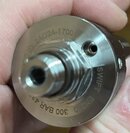- Messages
- 21,506
- Reaction score
- 21,781
- Location
- Philadelphia and Boynton Beach
- # of dives
- 2500 - 4999
I've never sent one in under warranty, so I would not know. It would not seem that they would charge you under warranty. I have had a perfectly good experience with Oceanic service, both before and after the acquisition by Huish. Not as quickly as Shearwater, but perfectly dependable.Oceanic/Huish doesn't' service the old ones. They just give you a refurbished one for $120, and presumably then get around someday to working on the one you sent in. It's a good deal, and reliable.
I had 2 Pro Plus 2s where the pressure sensors finally went out. These were from 2002. They replaced both of them with new or refurbished units after around 15 years, for just $175. Both of these computers are still in service, my wife and daughter love them.




